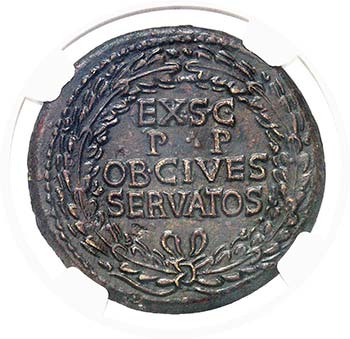- Home
- Numismatic Auction 18
- 61 Claude (41-54) Sesterce - Rome (42-43). Rare et magnifique ...
Lot 61 - Numismatic Auction 18
Bids
Description
Sesterce - Rome (42-43).
Rare et magnifique exemplaire.
Exemplaire de la vente Helbing 83 du 19 août 1941, N°653 et de la vente Münzen &
Medaillen 38 du 5 juin 2013, N°250.
30.87g - C. 38 - RIC 112 - Von Kaenel 1761 (this coin)
Superbe - NGC CHOICE XF * (5/5 4/5)
The bust on this coin is especially fine, which is rare for Claudius, and its reverse shows a wreath of oak-leaves around the legend OB CIVIS SERVATOS. This type refers to an award for saving the life of a fellow Roman, that had been bestowed upon Octavian-Augustus by the Roman senate (after he obtained in 20 BC from Phraates IV, the liberation of thousands of Roman citizens that had been made prisoners in Parthia). It was a great success for him, notably because he also obtained the standards which Crassus had lost in the battle of Carrhae – standards, which figure on the ‘Augustus of Prima Porta’ statue and which were stored in the Temple of Mars Ultor. This title was undoubtedly precious to Augustus’s eyes, as he chose the legend CAESAR COS VII CIVIBVS SERVATEIS – AVGVSTVS for what seems to be his first emission in gold (ref. Calicó 173). In the words of Cassius Dio, “Octavian had even before received many honours when the questions of declining the sovereignty and of allotting the provinces were being discussed. At that time, the privilege of placing the laurel trees in front of the royal residence, and of hanging the wreath of oak leaves [corona civica] above them, was voted in his honour to recognize in perpetuity his status as victor over his enemies and the savior of the citizens.” Recipients of the corona civica were entitled to various honours, one of which was having spectators rise as they entered a public theatre. The laurel branches were a sign of martial victory, that invoked his victory over Mark Antony and Cleopatra at Actium. The celebrated Austrian scholar J. H. von Eckhel commented: “This reverse, which makes its first appearance under Augustus, was frequently revived by succeeding Caesars, not often careful about whether such praise could truly be bestowed upon them” (Doctrina numorum veterum, new ed. 1828 vol. VI p. 121). And Stevenson added: “For example, words EX S. C. OB CIVES SERVATOS inscribed with a laurel crown forms the legend of the reverse on a first brass coin of Claudius, as if that most indolent and apathetic, if not most stupid, of Emperors ever did an heroic or humane action to merit the eulogy conveyed in this senatus consultum” (S. W. Stevenson, C. Roach Smith and F. W. Madden, A Dictionary of Roman Coins. Republican and Imperial, London 1889, p. 582). Claudius’ choice to use this type is noteworthy, considering that he had declined many of the honours traditionally bestowed on emperors.
Please use the registration form to send us your participation request, or, if you are already registered and authorized, use the login box on the top.
For any information please contact palombo.geneve@gmail.com
Categories
Auction: Numismatic Auction 18
- Celtic and Greek Coins
- Roman Coins
- Ajman
- Albania
- Germany
- Great Britain
- Annam
- Saudi Arabia
- Kingdom of Araucanía and Patagonia
- Australia
- Austria
- Belgium
- Brasil
- Bulgaria
- Cambodia
- Canada
- China
- Colombia
- Croatia
- Cuba
- Egypt
- United Arab Emirates
- Spain
- France
- Gabon
- Greece
- Guatemala
- Haiti
- Honduras
- Hungary
- French India
- Netherlands India
- Portuguese India
- French Indochina
- Iraq
- Iran
- Italy
- Lebanon
- Liechtenstein
- Malta
- Mexico
- Norway
- Netherlands
- Peru
- Poland
- Romania
- Russia
- San Marino
- Serbia
- Sweden
- Switzerland
- Transylvania
- Tunisia
- Usa
- Vatican
- Yugoslavia
Timetable
Pre-bidding - End
17 11 2019 14:00 CET
Room auction - Start
17 11 2019 16:00 CET
Contacts
Rue de la cité, 27, Genève, 1204, Switzerland
Cabinet Numismatique - Maison Palombo S.A. /// Rue de la cité, 27 - 1204 Genève - Suisse
tel : 0041-(0)22-310-91-97 /// fax : 0041-(0)22-310-30-74 /// Email : palombo.geneve@gmail.com /// www.maison-palombo-geneve.com
Powered by bid-KIT®
 Respecting your privacy is our priority
Respecting your privacy is our priority
This site uses cookies to improve user experience and to collect information on the use of the site. You can read our cookie policy, accept all cookies and continue browsing by clicking on "Accept" or customize your choice by clicking on "Customize".
Cookie Policy
Cookies
To make this site work properly, we sometimes install small data files called "cookies " on your device. Most of the big sites do the same.
What are cookies?
A cookie is a small text file that websites save on your computer or mobile device while you visit them. Thanks to cookies, the site remembers your actions and preferences (for example login, language, font size and other display settings) so that you do not have to re-enter them when you return to the site or browse from one page to another.
How do we use cookies?
Third party cookies
Google Analytics
This site uses Google Analytics to collect information about the use of users of its website. Google Analytics generates statistical and other information through cookies, stored on users' computers. The information generated relating to our website is used to make reports on the use of websites. Googl
How to control and modify cookies?
You can modify or withdraw your consent at any time from the cookie declaration on our website.
Privacy Policy
Find out more about who we are, how you can contact us and how we process personal data in our privacy policy .
The necessary cookies help to make the website usable by enabling basic functions such as page navigation and access to protected areas of the site. The website cannot function properly without these cookies.
| Name | Supplier | Purpose | Expiry |
|---|---|---|---|
| cookieConsent | Bid Inside | Stores the user's cookie consent status for the current domain | 6 months |
| PHPSESSID | Bid Inside | Preserve the user's status in the different pages of the site. | When the browsing session ends |
| f_display | Bid Inside | The f_display cookies memorize the display mode chosen by the user in the pages where there are lists | When the browsing session ends |
| f_page | Bid Inside | The f_page cookies store the page viewed by the user in the pages where there are lists | When the browsing session ends |
| f_rec_page | Bid Inside | The f_rec_page cookies store the number of elements to be displayed per page chosen by the user in the pages in which there are lists | When the browsing session ends |
| f_order_by | Bid Inside | The f_order_by cookies store the sorting parameter selected by the user in the pages where there are lists | When the browsing session ends |
| f_order_dir | Bid Inside | The f_order_dir cookies store the ordering direction chosen by the user in the pages where there are lists | When the browsing session ends |
| watch_list_show_imgs | Bid Inside | The watch_list_show_imgs cookie stores the user's choice to show or hide lot images on the watch list page | When the browsing session ends |
| selected_voice | Bid Inside | The selected_voice cookie stores the voice selected by the user for the speech synthesis present in the live auction | 1 Month |
| include_autobids | Bid Inside | The include_autobids cookie stores the user's choice to show or hide their auto-bids on the 'Your bids' page | 6 months |
Analytical cookies help to understand how visitors interact with the website, collecting and transmitting statistical information to the Data Controller.
| Name | Supplier | Purpose | Expiry |
|---|---|---|---|
| _ga | Register a unique ID used to generate statistical data on how the visitor uses the website. | 2 years | |
| _gat_gtag | Used by Google Analytics to limit the frequency of requests | 1 day | |
| _gat | Used by Google Analytics to limit the frequency of requests | 1 day | |
| _gid | Register a unique ID used to generate statistical data on how the visitor uses the website. | 1 day | |
| __utma | Bid Inside | Used to distinguish users and sessions. The cookie is created when the javascript library executes and no existing __utma cookies exists. The cookie is updated every time data is sent to Google Analytics. | 2 years |
| __utmt | Bid Inside | Used to throttle request rate. | 10 minutes |
| __utmb | Bid Inside | Used to determine new sessions/visits. The cookie is created when the javascript library executes and no existing __utmb cookies exists. The cookie is updated every time data is sent to Google Analytics. | 30 minutes |
| __utmc | Bid Inside | Not used in ga.js. Set for interoperability with urchin.js. Historically, this cookie operated in conjunction with the __utmb cookie to determine whether the user was in a new session/visit. | When the browsing session ends |
| __utmz | Bid Inside | Stores the traffic source or campaign that explains how the user reached your site. The cookie is created when the javascript library executes and is updated every time data is sent to Google Analytics. | 6 months |
| __utmv | Bid Inside | Used to store visitor-level custom variable data. This cookie is created when a developer uses the _setCustomVar method with a visitor level custom variable. This cookie was also used for the deprecated _setVar method. The cookie is updated every time data is sent to Google Analytics. | 2 years |
Preference technical cookies allow a website to remember information that affects the way the site behaves or presents itself, such as your preferred language or the region you are in.
We do not use cookies of this type.Profiling cookies are used for marketing purposes, to monitor website visitors. The intent is to display relevant and engaging ads for the individual user.
We do not use cookies of this type.Unclassified cookies are cookies that are being classified, together with individual cookie providers.
We do not use cookies of this type.





 62
62